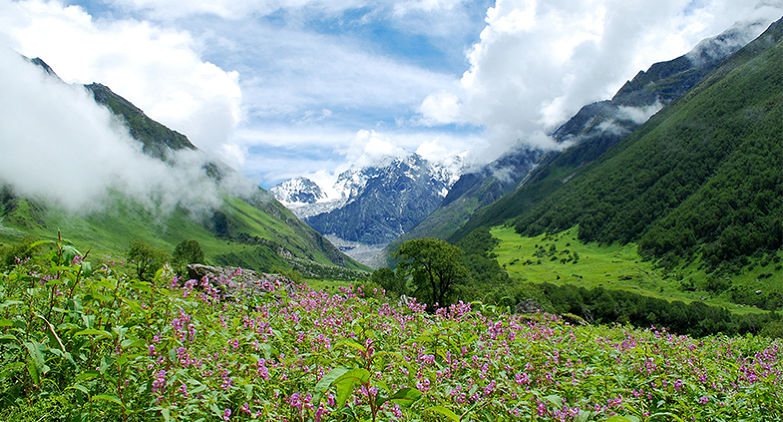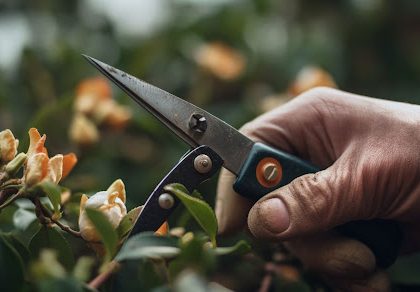Valley of Flowers Trek
The valley is about 2 kilometres wide and 8 kilometres long, and it is best to visit between July and mid-September. On this trek, the temperature ranges between 5 and 20 degrees Celsius. Even while trekking, there is a possibility of light rain, and the valley is usually shrouded in clouds. The most difficult part of the trek is the final day’s climb to Hemkund Sahib, where we cover about 4,300 feet in a day, which can be strenuous. It is a trek that offers a once-in-a-lifetime opportunity of visiting the Uttarakhand Himalayas, which have a valley covered in flowers. It is also famous as an excellent first-time trek for families and children. One also gets the opportunity to visit the holiest pilgrimage site of Hemkund Sahib.
You’ll even be able to visit Joan Margaret’s memorial grave while on the journey.The visit to Hemkund Sahib, the highest religious site covered in the itinerary, is challenging but rewarding, and if you have an extra day, you can even visit Badrinath or explore Rishikesh on your final day. Some sections of the trek have well-marked trails and a series of steps laid out. Mules run from Govindghat to Ghangaria and Hemkund Sahib, but they are not permitted to enter the main valley. You should not expect a luxurious stay while on the trek; there is no camping on this trek, and basic lodges with a seepage smell are provided.
During the valley of flowers trek days, there is a very high chance of rain. Keep an extra day in your itinerary in case of road closures due to rain. When hiking, it is essential to have a good quality rain jacket or poncho with you at all times. To keep the insides of the bag dry, use weather-resistant backpack covers. Waterproof trekking shoes are recommended, and several pairs of socks should always be carried when going on monsoon treks.
How to reach Valley of Flowers
From Delhi, you can take a train, a Volvo bus, or a private taxi to Haridwar. After that, you can take a local taxi from Haridwar to Govindghat in 10 to 12 hours. You can take a local bus from Govindghat to Pulna Village, which is only 4 kilometres away. When you arrive in Pulna, you can take a 10-kilometre moderate trekking trail to Ghangaria. You can also book a pony or a helicopter directly from Govindghat to Ghangaria. After arriving in Ghangaria village, you can follow a 10- to 20-kilometre trekking trail to the Valley of Flowers.
Things To Carry
You will need to bring good waterproofing because Valley of flowers trek is best done during the monsoon season. Bring a raincoat/poncho or a waterproof windcheater to fully protect yourself from the rain. Make sure your rain gear has a hood to keep your head dry in the rain.
- Rain jacket
- Warm clothes
- Caps
- Toilet paper & wipes
- Backpack
- Water bottle
- Fleece jackets and thermals
- Hiking boots
- Led torch
- Mosquito and insect repellent
- Thermal inners
Why Valley of Flowers is special:
You may have already fallen in love with the wow photos, which typically depict a mountain slope covered in wild flowers.Similar flower-covered slopes or ground can be found in some other valleys of the Himalayas. However, this valley is not unique due to the abundance of a few varieties during the monsoon season. But it is the sheer variety and quantity of flowers that combine to make Valley of Flowers a one-of-a-kind and must-see destination for nature lovers.
Difficulty level of Valley of Flowers trek
This is a Himalayan trek suitable for beginners.It is classified as a “Easy” grade trek. Although the total length of the trail is longer than many of our Easy grade treks, it is relatively gentle until Bhyundar village. The only climb until you reach Ghangaria is a moderately steep climb for about an hour from Bhundar bridge. For any Himalayan trek, it is always preferable and recommended to purchase specific warm clothing and trekking shoes. However, for the Valley of Flowers trek, you can reuse your existing warm clothing and good quality rubber soled sports shoes. It is possible that you will need to wear more than one layer of warm clothing.
Best time to visit
The seasonal bloom begins in the national park area as early as June. Some flowers bloom until the end of September. So you’ll get to see some flowers for about 16 weeks. However, as the monsoon season progresses, you will see more species diversity and flowering. Monsoon season begins in early July and lasts until late August in this region. As a result, visiting the Valley of Flowers in July or August is a good idea. Even if you visit in early September, you will see a green valley and some flowers.









